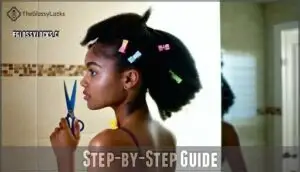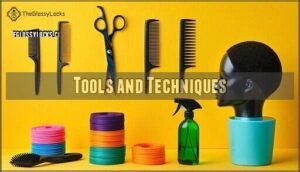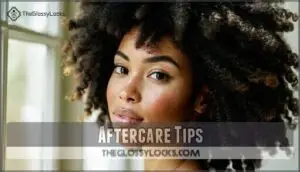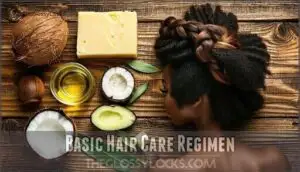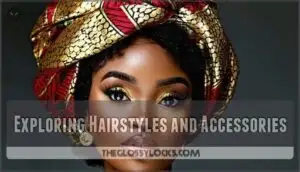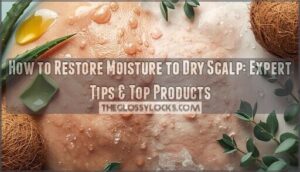This site is supported by our readers. We may earn a commission, at no cost to you, if you purchase through links.
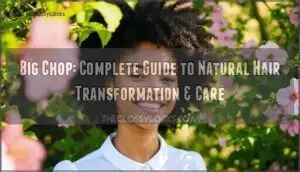
You’re basically saying goodbye to relaxers, perms, or years of straightening damage and embracing what grows naturally from your scalp. This isn’t just about length—it’s about freedom and authenticity.
Many people feel nervous about losing their hair length, but the big chop opens doors to discovering your true curl pattern and healthier hair growth. The key is proper preparation, the right mindset, and knowing what styling tricks work best afterward.
Table Of Contents
- Key Takeaways
- Understanding The Big Chop
- Preparing for The Big Chop
- Executing The Big Chop at Home
- Styling and Maintaining Natural Hair Post-Chop
- Embracing and Celebrating Your Natural Texture
- The Ongoing Journey: Growth and Care
- Frequently Asked Questions (FAQs)
- What is a big chop?
- What is a big chop for hair?
- Is a big chop right for You?
- Why should you eat a big chop?
- Is a big chop a good haircut?
- What does a big chop mean?
- How long does hair grow back after a big chop?
- Is the big chop better than transitioning?
- What are the benefits of the big chop?
- When should you do a big chop?
- Conclusion
Key Takeaways
- You’ll remove all chemically-treated hair in one cut to reveal your natural texture instantly, which eliminates the need to manage two different textures and gives you immediate clarity about your true curl pattern.
- You need to prepare emotionally for this major change by building confidence, managing expectations through research, and finding inspiration photos that match your hair type and desired outcome.
- You can execute the big chop at home with sharp hair cutting shears, proper sectioning techniques, and strategic mirror placement, but you should cut conservatively and work section by section for best results.
- You’ll need to establish a new hair care routine focused on gentle cleansing, weekly deep conditioning, and protective styling to maintain healthy natural hair growth and prevent damage.
Understanding The Big Chop
The big chop is when you cut off all your relaxed or chemically-treated hair to start fresh with your natural texture.
It’s the fastest way to begin your natural hair journey, though it requires letting go of length to embrace your hair’s true form.
Definition and Purpose
The big chop completely transforms your hair game by cutting off all chemically-treated strands in one decisive move.
This hair transformation isn’t just about length—it’s your ticket to discovering your authentic hair texture without the guesswork of evolving hair gradually.
**Why choose the big chop?
- It reveals your true curl pattern instantly
- Stronger, healthier growth begins immediately
- No more managing two different textures—just pure freedom
Think of it as hitting the reset button on your entire hair story. You’re removing damage accumulated over years while creating space for fresh start possibilities.
This natural hair journey begins the moment those scissors make their final cut, giving you immediate clarity about what you’re working with. A key benefit includes skipping the need to manage simultaneous hair textures.
- **You’ll finally meet the real you—the person who’s been hiding under layers of chemical processing.
The Journey to Natural Hair
When you set out on your natural hair journey, you’re reclaiming your natural identity and discovering who you truly are.
The big chop marks the beginning of hair empowerment—ditching chemicals for texture acceptance and authentic self-discovery.
This hair transformation connects you with a supportive community of women embracing their roots.
Your evolving hair becomes a symbol of freedom, teaching you that growth happens through patience, nourishment, and celebrating every curl’s unique story.
Preparing for The Big Chop
Getting ready for the big chop involves more than just picking up scissors—you’ll need to prepare emotionally and gather the right tools or find a skilled stylist.
This preparation stage helps guarantee you’ll love your new natural hair and feel confident with your fresh start.
Emotional Readiness
Now that you understand what the big chop involves, let’s talk about getting your mind ready for this powerful change.
Cutting off chemically treated hair isn’t just about scissors—it’s about embracing a new version of yourself. This identity shift can bring up feelings you didn’t expect. Some people worry about losing their familiar look or wonder if they’ll still feel beautiful with shorter hair.
Here’s how to build emotional readiness and confidence:
- Practice self-acceptance by looking at your natural texture with love
- Manage expectations by viewing photos of similar hair types post-chop
- Address fear of change by focusing on growth and freedom
- Seek community validation through online natural hair groups
- Celebrate this act of self-love as reclaiming your authentic beauty
Finding The Right Stylist or DIY Approach
The decision between professional stylist experience and DIY skills shapes your big chop journey.
A hairstylist consultation reveals cutting techniques that complement your face shape and natural texture. Ask consultation questions about their natural hair portfolio and dry-cutting methods.
Quality hair cutting shears make DIY possible, but rushing leads to regret. Professional stylists understand curl patterns and style expectations better than most beginners.
Whether you choose a hair stylist or tackle DIY, research thoroughly. Your big chop deserves patience and the right approach for your comfort level.
Gathering Inspiration and Setting Expectations
Once you’ve chosen your approach, it’s time to create your vision board. Start collecting images that spark joy—celebrity inspiration photos, texture comparisons, and hairstyle moodboards help clarify your goals.
A hair stylist consultation can provide realistic outcomes based on your specific texture and length preferences. Remember, expectation management is key since your natural hair might surprise you. Emotional readiness grows when you can visualize your big chop results.
- Picture yourself rocking a fierce TWA like Lupita Nyong’o at a red carpet event
- Imagine running your fingers through soft, chemical-free coils on a Sunday morning
- Envision confidently walking into work with your natural crown displayed proudly
Plan creatively: Choose a chop date that feels meaningful. Explore styling options: Short cuts or bold accessories can complement your look. Acknowledge emotions: Ups and downs are part of this empowering process.
Executing The Big Chop at Home
Cutting your own hair for the big chop might feel a bit intimidating, but with the right tools and steps, you can do it confidently.
By preparing carefully and following a clear process, you’ll set yourself up for a smooth and successful transformation.
Step-by-Step Guide
When you’re ready to make that life-changing cut, preparation is your best friend. Start with freshly washed, air-dried hair—this reveals your true curl pattern and makes sectioning methods crystal clear.
Divide your hair into four manageable sections using clips. This hair sectioning approach prevents confusion and guarantees even results. For effective styling, consider using quality hair clips for better control.
Position two mirrors strategically so you can see every angle while working.
Identify the line of demarcation where your natural texture meets processed hair. Here’s where cutting angles matter most—trim just below this line using sharp shears. Length considerations are vital, so cut conservatively at first.
You can always trim more later. Work section by section, using your first cut as a guide for consistency.
Avoid common DIY mistakes like cutting too much at once or using dull scissors. These hair cutting techniques require patience, but the reward is worth it.
Take breaks if you feel overwhelmed—this big chop journey is yours to control.
Tools and Techniques
Sharp shears make all the difference when executing your big chop—kitchen scissors won’t cut it (literally). Quality hair cutting tools prevent damage and guarantee clean cuts through your natural texture.
Master these hair sectioning techniques for professional results:
- Use wide-tooth combs to detangle each section gently
- Secure rubber banding just above your natural growth line
- Position mirrors at multiple angles for complete visibility
- Cut small amounts gradually to avoid overcutting mistakes
- Keep spray bottles handy for maintaining moisture during the process
Sectioning methods involve dividing hair into manageable squares. Hair trimming works best when you cut below the demarcation line. For tapered cuts or bang creation, consider your face shape and natural growth patterns. Changing styles benefit from protective styling methods to minimize breakage. These hair cutting techniques help you achieve that fresh, liberated look you’re after.
Aftercare Tips
Your fresh cut deserves royal treatment to reveal its full potential.
Hydration is your new best friend—weekly deep conditioning treatments keep curls bouncing with life.
Master protective styling with gentle twists or silk scarves to lock in moisture and prevent breakage.
Product selection becomes your personal experiment; creams, gels, and oils react differently to each texture.
Don’t forget scalp health—massage with lightweight oils to stimulate growth.
These damage prevention strategies transform your hair care routine into a celebration of natural beauty and healthy hair maintenance.
Styling and Maintaining Natural Hair Post-Chop
You’ve made the cut, and now your natural hair needs the right care to thrive and look its best.
Learning proper styling techniques and choosing the correct products will help you create a routine that keeps your hair healthy, moisturized, and beautifully defined.
Basic Hair Care Regimen
Now that you’ve made the cut, your natural hair needs a customized care routine that works with its unique texture. Cleansing Frequency matters—wash once or twice weekly to preserve natural oils while removing buildup. Choose hair products with nourishing Product Ingredients like shea butter and avoid harsh sulfates that strip moisture.
Deep Conditioning weekly strengthens your strands and boosts elasticity. Understanding your hair porosity helps you select products that penetrate properly. Don’t forget Scalp Health—a clean, balanced scalp promotes healthy growth.
To maintain healthy hair, remember that protective styling reduces manipulation. Your hair care routine should include:
- Gentle cleansing that doesn’t over-dry your curls
- Weekly deep treatments that restore moisture and strength
- Leave-in conditioners that provide daily hydration
- Protective Styling methods that minimize breakage
Consistent hair maintenance keeps your natural texture thriving. The L.O.C. method—leave-in, oil, cream—seals in moisture effectively for lasting hair styling success.
Exploring Hairstyles and Accessories
After establishing your hair care routine, styling your post-big chop look becomes the fun part.
Your TWA (teeny weeny afro) opens doors to creative expression through accessories and protective styles. Short natural hair offers surprising versatility when you know the right techniques.
Transform your look with these accessorizing tips:
- Head Wrap Tutorials: Master colorful wraps for instant elegance and hair protection
- Hair Jewelry: Add gold barrettes, decorative clips, or beads for personalized flair
- Protective Styles: Try twist-outs, bantu knots, or finger coils for defined texture
- Statement Accessories: Use headbands, scarves, or bold earrings to complement your natural hair styling
Discover how to master various head-wrap styles for any occasion. Your big chop journey just got more exciting with endless hairstyles to explore.
Selecting The Right Hair Care Products
Success in product selection starts with ingredient analysis and understanding your hair’s porosity needs.
Choose sulfate-free shampoos, deep conditioners, and lightweight leave-in treatments for your post-chop routine.
Many find that gentle cleansers matter for maintaining hair health.
Start with trial sizes and budget options to find what works.
Hair styling products like curl creams and hair care products with natural oils will define your texture perfectly.
Embracing and Celebrating Your Natural Texture
Your natural texture is unique and beautiful, and learning to love it takes time and patience.
You’ll discover new ways to care for your hair while building confidence in your natural look through community support and personal growth.
Coping With Challenges and Setbacks
Your natural hair journey won’t always be smooth sailing. Patience and self-acceptance become your best friends when facing challenges like slow growth or texture changes. Don’t let setbacks shake your confidence—they’re part of the process.
A key part of progressing is understanding your individual hair growth and setting realistic expectations.
Here’s how to stay strong:
- Celebrate milestones, even tiny ones like your first successful wash-and-go
- Maintain a positive outlook by focusing on progress, not perfection
Remember, every curl has its own timeline for success.
Finding Community Support
You’ll find your tribe in the natural hair community—people who truly understand your big chop journey.
Online forums buzz with tips and encouragement, while hair influencers share real-world advice that works.
Local meetups let you connect face-to-face with others experiencing similar experiences.
Support groups offer judgment-free spaces to celebrate wins and work through tough days.
Even family acceptance grows when they see your confidence shine.
This hair community becomes your cheerleading squad, making every twist-out and wash day feel like a shared victory.
The Psychological Impact of Going Natural
Embracing your natural hair after the big chop isn’t just about curls—it’s an identity shift that can boost confidence and self-esteem.
It’s normal to face emotional challenges, but this journey is worth it. Think of it as shedding old expectations to uncover your authentic self.
- Acknowledge feelings – It’s okay to feel unsure; growth comes with discomfort.
- Celebrate uniqueness – Your natural hair tells a story no one else can.
- Lean on community support – Connect with others for encouragement.
- Practice self-acceptance – Love your hair, flaws and all—it’s uniquely yours.
The Ongoing Journey: Growth and Care
Once you’ve completed your big chop, you’ll need to establish a consistent care routine that supports healthy growth and maintains your hair’s natural texture.
Your natural hair journey continues with regular trims, protective styling, and proper moisturizing techniques that keep your hair strong and thriving.
Routine Trims and Healthy Practices
After celebrating your natural texture, maintaining it becomes your next priority.
Regular hair trims every 6-8 weeks prevent split ends and boost growth stimulation. Your hair care routine should include weekly deep conditioning for ideal hydration methods and scalp health.
Combat product build-up with clarifying shampoos monthly. Think of trimming like pruning a garden—removing damaged ends encourages stronger hair growth tips.
Quality hair trims using sharp scissors maintain your shape while promoting healthy hair. These consistent practices create the foundation for long-term hair health success.
Protective Styles and Their Benefits
Armor for your hair—that’s what protective styles offer after your big chop journey begins.
These versatile options shield your delicate strands from daily wear and environmental damage while promoting healthy growth.
Braids provide excellent damage prevention by keeping ends tucked away from friction and manipulation.
You’ll love how they reduce tangling while maintaining your hair’s natural moisture retention.
Twists offer similar braid benefits with easier installation and removal.
Weave protection creates a barrier between your natural hair and styling tools, heat, and harsh weather.
This style longevity means less frequent manipulation and healthier strands over time.
The real magic happens with growth stimulation—protective styles give your hair the break it needs to flourish.
Your ends stay protected from splitting and breakage, allowing you to retain length effectively.
From sleek updos to creative cornrows, these styles celebrate your natural texture while keeping it safe.
You’re not hiding your hair; you’re nurturing it toward its full potential.
Moisturizing and Detangling Techniques
How do you keep your natural hair thriving after the big chop? Mastering moisturizing and hair detangling becomes your secret weapon.
Use sulfate-free shampoos and deep conditioners for maximum moisture retention. Wide-tooth combs and detangling brushes work well, but your fingers remain the gentlest detangling tools for 4c textures.
- Check product ingredients—avoid sulfates and drying alcohols that strip natural oils
- Practice hydration techniques like the L.O.C. method (Liquid, Oil, Cream) for maximum moisture
- Incorporate overnight care with silk bonnets or pillowcases to prevent friction
- Master protective styling between wash days to maintain healthy, detangled hair
Frequently Asked Questions (FAQs)
What is a big chop?
You’re cutting off all your relaxed or chemically-treated hair to embrace your natural texture.
It’s the fastest way to start fresh, removing damaged ends and beginning your natural hair journey immediately.
What is a big chop for hair?
Long chemically-treated hair versus short natural texture—that’s the dramatic transformation you’ll experience.
A big chop means cutting off all relaxed or processed hair to reveal your natural curl pattern underneath.
Is a big chop right for You?
You’re ready if you want immediate results, feel emotionally prepared for shorter hair, and desire a fresh start.
Consider your lifestyle, styling preferences, and commitment to natural hair care before making this transformative decision.
Why should you eat a big chop?
Like medieval knights shedding armor, you shouldn’t "eat" a big chop—you do one.
This hair transformation removes damaged ends, reveals your natural texture, and kickstarts healthier growth while boosting confidence instantly.
Is a big chop a good haircut?
A big chop can absolutely be a great haircut choice.
You’ll discover your natural texture, enjoy easier styling, and experience liberating confidence.
It’s transformative, healthy for damaged hair, and opens doors to exciting new styling possibilities.
What does a big chop mean?
Picture scissors cutting through years of chemical processing like a clean slate.
A big chop means cutting off all your relaxed or chemically-treated hair to embrace your natural texture completely and start fresh.
How long does hair grow back after a big chop?
Your hair typically grows about half an inch monthly after cutting.
You’ll see noticeable length in 3-6 months, with shoulder-length results in 1-2 years depending on your growth rate and care routine.
Is the big chop better than transitioning?
You’ll get instant results with cutting off all chemically-treated hair at once, while going natural takes months or years.
Choose based on your patience level, emotional readiness, and desired timeline for natural hair.
What are the benefits of the big chop?
Ready for instant transformation? You’ll remove all damaged hair immediately, discover your true texture, simplify your routine with single-texture products.
Boost confidence dramatically, and start fresh without lengthy adjustment periods or mixed textures, which will help you simplify your routine and start fresh.
When should you do a big chop?
You should do it when you’re emotionally ready to embrace short hair and want immediate results. Consider timing it when you’ve grown several inches of natural hair for styling options.
Conclusion
Embracing your big chop is like planting seeds in fertile soil—the real magic happens with time and care.
You’ve learned the essential steps, from preparation to styling your natural texture.
Remember, this journey isn’t just about hair; it’s about discovering your authentic self.
Every curl has its own personality, and yours deserves celebration.
Stay patient with the process, connect with others on similar paths, and trust that your natural hair will flourish beautifully.


